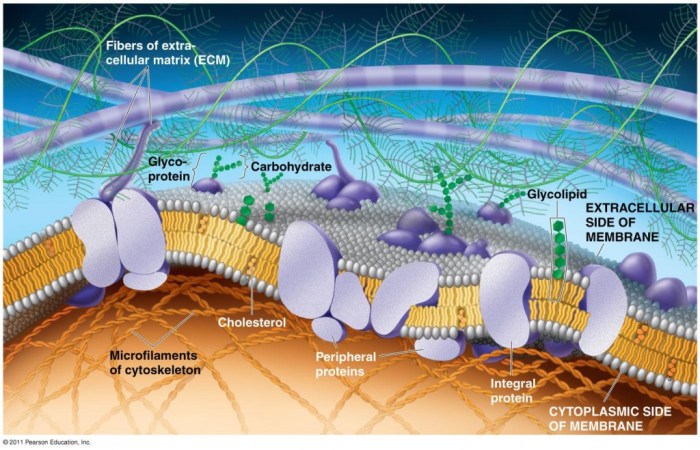In biological systems membrane channels are usually permeable to – In biological systems, membrane channels are usually permeable to specific ions, enabling the selective transport of ions across cell membranes. These channels play a crucial role in maintaining cellular homeostasis, transmitting electrical signals, and regulating various physiological processes.
Membrane channels exhibit diverse properties, including ion selectivity, voltage-dependence, and regulation by signaling molecules. Understanding the mechanisms and regulation of membrane channel permeability is essential for comprehending cellular function and pathophysiology.
Ion Permeability

In biological systems, membrane channels are usually permeable to specific ions, allowing them to selectively cross the membrane barrier. This selective permeability is crucial for maintaining cellular homeostasis, regulating cell volume, and facilitating various physiological processes.
Role of Membrane Channels
Membrane channels are embedded in the lipid bilayer of cell membranes and form hydrophilic pores that allow ions to pass through. They are highly selective, allowing the passage of specific ions based on their charge, size, and other characteristics.
Examples of specific ion channels include:
- Sodium channels: Allow the passage of sodium ions (Na+) into the cell, facilitating nerve impulses and muscle contractions.
- Potassium channels: Allow the passage of potassium ions (K+) out of the cell, contributing to the resting membrane potential and regulating cell excitability.
- Chloride channels: Allow the passage of chloride ions (Cl-) into or out of the cell, maintaining cellular pH and fluid balance.
Factors Influencing Permeability

The permeability of membrane channels is influenced by several factors, including:
Channel Structure and Size
The structure and size of the channel determine which ions can pass through. Smaller ions, such as sodium and potassium, can pass through narrow channels, while larger ions, such as calcium and chloride, require wider channels.
Charge Selectivity
Membrane channels exhibit charge selectivity, allowing the passage of ions with a specific charge. For example, sodium channels are positively charged and allow the passage of positively charged sodium ions.
Voltage and Chemical Gradients
Voltage and chemical gradients across the membrane can also influence channel permeability. Voltage-gated channels open or close in response to changes in the electrical potential across the membrane, while ligand-gated channels open or close in response to the binding of specific chemical messengers.
Transport Mechanisms

Ions are transported across membranes through various mechanisms:
Passive Diffusion
Passive diffusion is the movement of ions down their concentration gradient, from areas of high concentration to areas of low concentration. This process does not require energy input.
Facilitated Diffusion
Facilitated diffusion is the movement of ions across the membrane with the assistance of transport proteins. These proteins bind to the ions and facilitate their passage through the membrane, increasing the rate of transport.
Active Transport
Active transport is the movement of ions against their concentration gradient, from areas of low concentration to areas of high concentration. This process requires energy input in the form of ATP.
Regulation of Permeability
The permeability of membrane channels is tightly regulated to maintain cellular homeostasis and respond to various stimuli:
Hormones and Neurotransmitters
Hormones and neurotransmitters can bind to receptors on membrane channels, causing conformational changes that alter channel permeability.
Second Messengers
Second messengers, such as cAMP and IP3, can also modulate channel permeability by activating specific kinases or phosphatases that phosphorylate or dephosphorylate channel proteins.
Mechanical Stress, In biological systems membrane channels are usually permeable to
Mechanical stress, such as stretching or compression of the cell membrane, can also affect channel permeability.
Pathophysiological Implications: In Biological Systems Membrane Channels Are Usually Permeable To
Dysfunction of membrane channels can have significant pathophysiological implications:
Channel Mutations and Disorders
Mutations in membrane channel genes can lead to various disorders, such as cystic fibrosis, epilepsy, and arrhythmias.
Diseases Associated with Channel Abnormalities
Examples of diseases associated with membrane channel abnormalities include:
- Cystic fibrosis: Caused by mutations in the cystic fibrosis transmembrane conductance regulator (CFTR) chloride channel.
- Epilepsy: Caused by mutations in various ion channels, including sodium, potassium, and calcium channels.
- Arrhythmias: Caused by mutations in ion channels involved in the electrical conduction system of the heart.
User Queries
What is ion permeability?
Ion permeability refers to the ability of ions to pass through a membrane channel. It is determined by the channel’s selectivity, size, and charge.
How do membrane channels facilitate ion movement?
Membrane channels provide a pathway for ions to cross the hydrophobic lipid bilayer of cell membranes. They can be either passive or active, allowing ions to move down electrochemical gradients or against them, respectively.
What are some examples of specific ion channels?
There are numerous types of ion channels, each with specific ion selectivity. Examples include sodium channels, potassium channels, and calcium channels, which play crucial roles in electrical signaling and cellular processes.